SCHEME OF WORK
WEEK TOPIC
1. Meaning, Definition and Importance of Agriculture.
2. Evolution of Agriculture (Historical Development of Agriculture)- History/Gathering, Settled/Commercial farming.
3. Types of Agriculture-(levels of agriculture) Subsistence and Commercial (Characteristics Required).
4. Forms/ Branches of Agriculture (Crops).
5. Forms/ Branches of Agriculture (Livestock) (Cont.).
6. Crop Plant Forms- Identifying parts of flowering plants- Leaf, Root, Stem, flower (function of the parts required).
7. Crop Plant Forms (cont. (a) Aquatic form(b) Terrestrial Form(c) Broad leaf Crops (d)Narrow leaf crops.
8. Crop Plant forms (cont.) (d) Monocotyledons (e) Dicotyledons (Differences between Monocot & Dicot Required).
9. Revision
1ST TERM
WEEK 1
LESSON 1
TOPIC: Meaning, Definition and Importance of Agriculture
CONTENT: 1. Meaning of Agriculture
2. Definition of Agriculture.
3. Importance of Agriculture.
Meaning of Agriculture.
The term “agriculture” is derived form two Latin words “ager” which means field and “cultura” which means to cultivate. Literally, agriculture means field cultivation. Field refers to a farmland where crops or animals are taken care of. Cultivation refers to the act of nurturing or taking care of crops.
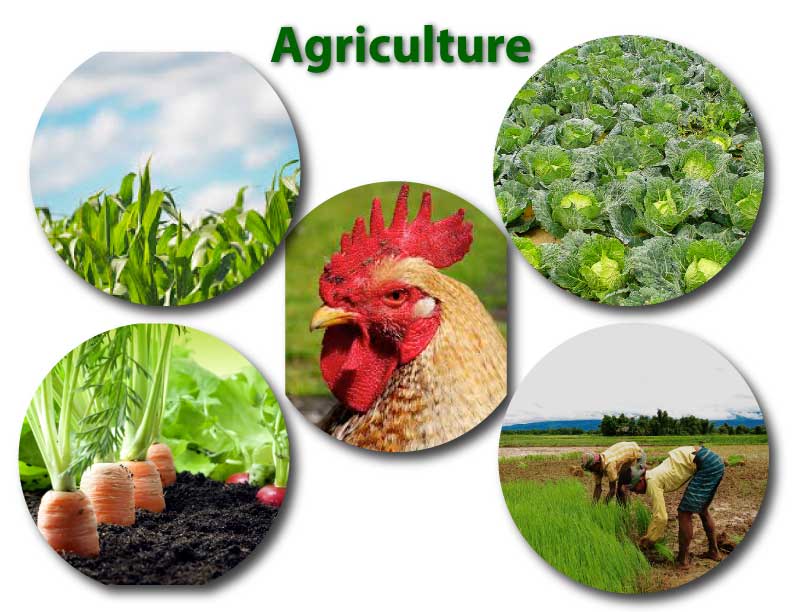
Definitions of Agriculture
According to an author, Agriculture by definition, is an art involving the production of plants and animals for the use of man. This use may be in the form of food, buildings, ornaments and clothing or it may be in the form of raw materials for industry.
In another sense, agriculture is the art and science of cultivating the land for the production of crops and rearing of animals for man’s use. It involves not only the management of the soil, crops and animals but also the disposal of crops and animals including their by – products through marketing.
EVALUATION:
• Mention the two Latin words from which the term “agriculture” is derived.
• Literally, what does agriculture refer to?
• Define agriculture.
LESSON 2
Importance of Agriculture.
A. The importance of agriculture to the farmer.
Agriculture is import to the farmer in the following ways:
• Agriculture provides food for the farmer to keep him and his family alive. Food is the source of Carbohydrates, Proteins, Fats and Oils, Vitamins and Minerals required and development.
• It provides income (money) from the sales of farm produce for local farmers.
• It provides shelters for the farmer and his domesticated animals. Roofing and furnishing materials used for building are provided form agriculture.
• It provides transport (e.g. Camels. Donkeys and horses) are beasts of burden for carrying people and farm produce.
• It provides fuel wood/firewood as source of energy for cooking.
• It provides herbs and other substances, which serve as medicinal helps to the people.
• It provides employment for many people. About 70% of the Nigerian populations are farmers. They are self-employed in local farming.
B. Importance of agriculture to the society.
The importance of agriculture to the immediate society cannot be overemphasized. People moving in the streets, in the office or in school at the end of daily activities need (food, clothing, shelter) and other necessities to life most of which come from agricultural sector. Therefore, every member of every household in the society depends directly or indirectly on agriculture for daily sustenance.
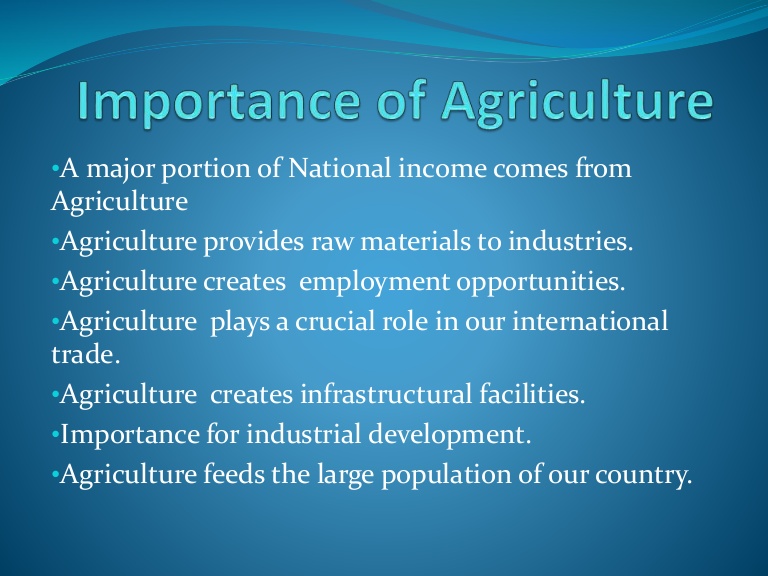
C: Importance of agriculture to the Nation.
• Provision of Employment
Agriculture provides employment for many people in most African Countries. Majority of these people are farmers and they produce food for the nation.
• Raw materials for Industries.
Agriculture provides raw materials such as Cottons for textile mills; timber for saw mills, cocoa and coffee for beverage making, etc. .
• Foreign exchange for countries:
The surplus produce of a country can be exported to increase the foreign exchange e.g. Nigeria exchange cocoa, rubber for electronics, refrigerators, fans, etc from countries like Japan and USA.
• Source of National Income:
Agriculture is Nigeria’s second largest source of National income/wealth after oil. Revenue is realized from government sales of agricultural industries as well as export duties.
EVALUATION
• State the purpose of agriculture to the farmer.
• Explain why agriculture is important to the society.
• Why are the pupils, students, employers, the jobless in the society able to survive from day to day?
• Why is agriculture regarded as a source of energy to the farmer?
• What is the importance of agriculture to the nation?
Assignment:
Junior secondary Agriculture (workbook 1)byAnthony.Youdeowei et-al pages 1& 2
Pre – reading Assignment :
Read about the origjn and history of agriculture as the next topic.
Activity.
Make a list of 10 crops and five animal items useful to man.
REFERENCE TEXTS:
• Intensive Agricultural Science for J.S.S. 1, 2 & 3 by E. U. Okaro.
• Essentials of Agricultural Science for J.S.S. & Colleges by Earnest Chukwudi Anie.
• Agricultural Science for JSS (Upper Basic Education) by L. A. Are et al.
• Prescribed Agricultural Science for J.S.S. by S. E. Omoruyi et al.
TOPIC: Meaning, Definition and Importance of Agriculture
CONTENT: 1. Meaning of Agriculture
2. Definition of Agriculture.
3. Importance of Agriculture.
Meaning of Agriculture.
The term “agriculture” is derived form two Latin words “ager” which means field and “cultura” which means to cultivate. Literally, agriculture means field cultivation. Field refers to a farmland where crops or animals are taken care of. Cultivation refers to the act of nurturing or taking care of crops.

Definitions of Agriculture
According to an author, Agriculture by definition, is an art involving the production of plants and animals for the use of man. This use may be in the form of food, buildings, ornaments and clothing or it may be in the form of raw materials for industry.
In another sense, agriculture is the art and science of cultivating the land for the production of crops and rearing of animals for man’s use. It involves not only the management of the soil, crops and animals but also the disposal of crops and animals including their by – products through marketing.
EVALUATION:
• Mention the two Latin words from which the term “agriculture” is derived.
• Literally, what does agriculture refer to?
• Define agriculture.
LESSON 2
Importance of Agriculture.
A. The importance of agriculture to the farmer.
Agriculture is import to the farmer in the following ways:
• Agriculture provides food for the farmer to keep him and his family alive. Food is the source of Carbohydrates, Proteins, Fats and Oils, Vitamins and Minerals required and development.
• It provides income (money) from the sales of farm produce for local farmers.
• It provides shelters for the farmer and his domesticated animals. Roofing and furnishing materials used for building are provided form agriculture.
• It provides transport (e.g. Camels. Donkeys and horses) are beasts of burden for carrying people and farm produce.
• It provides fuel wood/firewood as source of energy for cooking.
• It provides herbs and other substances, which serve as medicinal helps to the people.
• It provides employment for many people. About 70% of the Nigerian populations are farmers. They are self-employed in local farming.
B. Importance of agriculture to the society.
The importance of agriculture to the immediate society cannot be overemphasized. People moving in the streets, in the office or in school at the end of daily activities need (food, clothing, shelter) and other necessities to life most of which come from agricultural sector. Therefore, every member of every household in the society depends directly or indirectly on agriculture for daily sustenance.

C: Importance of agriculture to the Nation.
• Provision of Employment
Agriculture provides employment for many people in most African Countries. Majority of these people are farmers and they produce food for the nation.
• Raw materials for Industries.
Agriculture provides raw materials such as Cottons for textile mills; timber for saw mills, cocoa and coffee for beverage making, etc. .
• Foreign exchange for countries:
The surplus produce of a country can be exported to increase the foreign exchange e.g. Nigeria exchange cocoa, rubber for electronics, refrigerators, fans, etc from countries like Japan and USA.
• Source of National Income:
Agriculture is Nigeria’s second largest source of National income/wealth after oil. Revenue is realized from government sales of agricultural industries as well as export duties.
EVALUATION
• State the purpose of agriculture to the farmer.
• Explain why agriculture is important to the society.
• Why are the pupils, students, employers, the jobless in the society able to survive from day to day?
• Why is agriculture regarded as a source of energy to the farmer?
• What is the importance of agriculture to the nation?
Assignment:
Junior secondary Agriculture (workbook 1)byAnthony.Youdeowei et-al pages 1& 2
Pre – reading Assignment :
Read about the origjn and history of agriculture as the next topic.
Activity.
Make a list of 10 crops and five animal items useful to man.
REFERENCE TEXTS:
• Intensive Agricultural Science for J.S.S. 1, 2 & 3 by E. U. Okaro.
• Essentials of Agricultural Science for J.S.S. & Colleges by Earnest Chukwudi Anie.
• Agricultural Science for JSS (Upper Basic Education) by L. A. Are et al.
• Prescribed Agricultural Science for J.S.S. by S. E. Omoruyi et al.
WEEK 2
LESSON 3
TOPIC: THE ORIGIN AND HISTORY OF AGRICULTURE.
The Origin of Agriculture.
Agriculture is as old as the early man. The earliest man practiced fruit gatherings and hunting of animals, which they used as food. The early man and his family fed on wild animals, roots, leaves and fruits collected as they wander from place to place. The type and quantity available at the time required irregular, uncertain and subject to the conditions they found themselves they continued with their nomadic life until they could no longer carry their families about.
The beginning of agriculture and the early farming tools.
As families increased, a more settled form of agriculture became inevitable. As they settled for a
long time in a place, they discovered that some of the seeds of fruits thrown around their dwelling place germinated, grew and produced the same fruits of their kinds. They started to cultivate the land, sowed seeds, took care of the growing crops, harvested them, and made use of them. Also, captured young animals were tamed. They grew and gave birth to young ones, fed them and later killed them and used them as meat. The tools used by the early man for cultivating crops include wooden sticks with burnt ends and sharp edges. While the tools used for hunting animals include stones, bow and arrows strong sticks and ropes.

In the history of Agriculture four stages are very pronounced. These are :
i. Hunting and gathering stage: The early men went about gathering fruits ,leaves, roots of wild plants and hunting wild animals in other to obtain daily food. They used primitive tools likes stones, bows and arrows , traps and ropes. It is a very dangerous way to obtain food.
ii. Subsistence Farming stage: The primitive man found out that whenever he threw away seeds of recognized useful plants around his house, the seeds grew into new and useful plants He also found that he could capture some young animals or their pregnant mothers and look after the young ones when they were born. This is the beginning of crop and animal farming to take care of their family
iii. Cash crop production stage: As time went by primitive man learn how to grow his crops and rear the animals in a better way. He began to produce cash crops.
iv. Commercial Farming stage: This is the stage when men started producing crop and animals on large scale not only for family needs but also for sale.
Improvement of Agriculture from Primitive to modern Agriculture.
The men were usually out for hunting while the women helped to prepare the gathered crops and dressed the animals for food. As man increases in knowledge and technology, better-improved crops and animals were produced. Also, improved farming equipments such as cutlasses, spade, hoes and wheelbarrows replaced the primitive tools. More improvement being made gave rise to machines such as tractors, bulldozer, modern implements, etc that are now used these days.

EVALUATION
• Explain the Origin of agriculture?
• How were the early men surviving before the cultivation of crops started?
• Mention some of the food they were eating.
• How did planting of crops start?
• How were the animals tamed by early farmers?
• What were the tools of early farmers?
• Mention the four stages in the development of Agriculture
• Explain how primitive agriculture grew to modern farming methods and improved farm machines
Assignment.
Sketch two primitive tools and two improved metals tools used by the early man.
REFERENCE TEXTS:
• Intensive Agricultural Science for J.S.S. 1, 2 & 3 by E. U. Okoro.
• Essentials of Agricultural Science for J.S.S. & Colleges by Earnest Chukwudi Anie.
• Agricultural Science for JSS (Upper Basic Education) by L. A. Are et al.
• Prescribed Agricultural Science for J.S.S. by S. E. Omoruyi et al.
TOPIC: THE ORIGIN AND HISTORY OF AGRICULTURE.
The Origin of Agriculture.
Agriculture is as old as the early man. The earliest man practiced fruit gatherings and hunting of animals, which they used as food. The early man and his family fed on wild animals, roots, leaves and fruits collected as they wander from place to place. The type and quantity available at the time required irregular, uncertain and subject to the conditions they found themselves they continued with their nomadic life until they could no longer carry their families about.
The beginning of agriculture and the early farming tools.
As families increased, a more settled form of agriculture became inevitable. As they settled for a
long time in a place, they discovered that some of the seeds of fruits thrown around their dwelling place germinated, grew and produced the same fruits of their kinds. They started to cultivate the land, sowed seeds, took care of the growing crops, harvested them, and made use of them. Also, captured young animals were tamed. They grew and gave birth to young ones, fed them and later killed them and used them as meat. The tools used by the early man for cultivating crops include wooden sticks with burnt ends and sharp edges. While the tools used for hunting animals include stones, bow and arrows strong sticks and ropes.

In the history of Agriculture four stages are very pronounced. These are :
i. Hunting and gathering stage: The early men went about gathering fruits ,leaves, roots of wild plants and hunting wild animals in other to obtain daily food. They used primitive tools likes stones, bows and arrows , traps and ropes. It is a very dangerous way to obtain food.
ii. Subsistence Farming stage: The primitive man found out that whenever he threw away seeds of recognized useful plants around his house, the seeds grew into new and useful plants He also found that he could capture some young animals or their pregnant mothers and look after the young ones when they were born. This is the beginning of crop and animal farming to take care of their family
iii. Cash crop production stage: As time went by primitive man learn how to grow his crops and rear the animals in a better way. He began to produce cash crops.
iv. Commercial Farming stage: This is the stage when men started producing crop and animals on large scale not only for family needs but also for sale.
Improvement of Agriculture from Primitive to modern Agriculture.
The men were usually out for hunting while the women helped to prepare the gathered crops and dressed the animals for food. As man increases in knowledge and technology, better-improved crops and animals were produced. Also, improved farming equipments such as cutlasses, spade, hoes and wheelbarrows replaced the primitive tools. More improvement being made gave rise to machines such as tractors, bulldozer, modern implements, etc that are now used these days.

EVALUATION
• Explain the Origin of agriculture?
• How were the early men surviving before the cultivation of crops started?
• Mention some of the food they were eating.
• How did planting of crops start?
• How were the animals tamed by early farmers?
• What were the tools of early farmers?
• Mention the four stages in the development of Agriculture
• Explain how primitive agriculture grew to modern farming methods and improved farm machines
Assignment.
Sketch two primitive tools and two improved metals tools used by the early man.
REFERENCE TEXTS:
• Intensive Agricultural Science for J.S.S. 1, 2 & 3 by E. U. Okoro.
• Essentials of Agricultural Science for J.S.S. & Colleges by Earnest Chukwudi Anie.
• Agricultural Science for JSS (Upper Basic Education) by L. A. Are et al.
• Prescribed Agricultural Science for J.S.S. by S. E. Omoruyi et al.
WEEK 3
LESSON 4
TOPIC: TYPES OF AGRICULTURE.
Types of Agriculture
There are two types of agriculture. They include:
• Subsistence Agriculture
• Commercial Agriculture.
SUBSISTENCE AGRICULTURE:
This is the type of agriculture whereby a farmer produces food enough to feed himself and his family, with little or more for sale. Whatever he sells serves as income to the family.
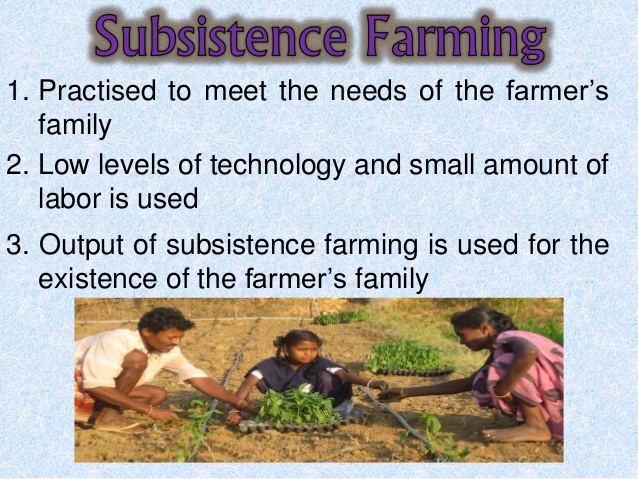
Characteristics of Subsistence Agriculture
• Produces purposely for family consumption.
• Small land is used for production
• Farmer and his family members do the labour.
• Simple farm tools like hoe, cutlass, spade, rake etc. are used.
• Many crops are planted on the same plot. e.g. maize, melon, yam, vegetables. In other words, he practices mixed cropping system.
• Fertilizers, herbicides, pesticides are not used commonly.
• Usually owned by peasant farmers.
• No specialization on any particular crop.
• Small capital is needed by the farmer.

Commercial Agriculture
This is the type of agriculture whereby a farmer produces purposely for sale. His desire is to make maximum profit. It is therefore a profit-oriented venture/enterprise.
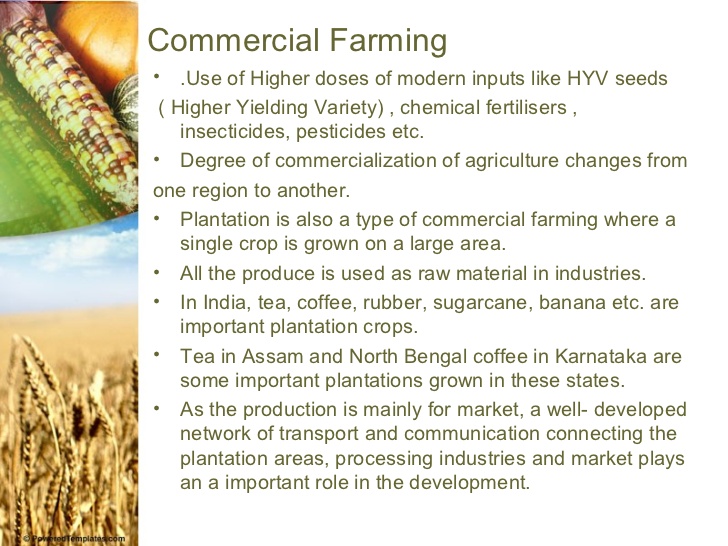
Characteristics of Commercial Agriculture
• Produce purposely for sale to make maximum profit.
• Large area of land is used as a result large-scale production is made.
• Hired and skilled workers are used for labour.
• Modern farm, implements are used.
• Mono-cropping system is usually practiced e.g. only maize or rice because of the use of farm machines in farm operation.
• Fertilizers, herbicides pesticides and many other chemicals are used
• It is usually owned government or limited companies.
• It leads to specialization on certain types of crops.
• Large capital is involved.
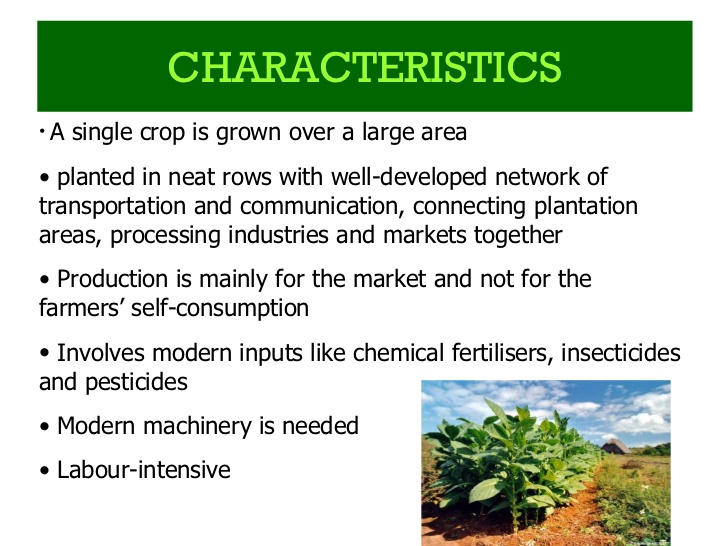
EVALUATION
• Define Subsistence Agriculture
• List (4) four characteristics of subsistence agriculture.
• Define commercial agriculture.
• List the characteristics of commercial agriculture.
LESSON 5
Difference between Subsistence and Commercial Agriculture.

EVALUATION
• State five differences between subsistence agriculture and commercial agriculture.
Assignment
Junior secondary Agriculture (workbook 1)byAnthony.Youdeowei et-al pages 3 & 4
Pre-reading Assignment
Read the forms of agriculture using Junior secondary Agriculture, book1
REFERENCE TEXTS:
• Intensive Agricultural Science for J.S.S. 1, 2 & 3 by E. U. Okoro.
• Essentials of Agricultural Science for J.S.S. & Colleges by Earnest Chukwudi Anie.
• Agricultural Science for JSS (Upper Basic Education) by L. A. Are et al.
• Prescribed Agricultural Science for J.S.S. by S. E. Omoruyi et al.
TOPIC: TYPES OF AGRICULTURE.
Types of Agriculture
There are two types of agriculture. They include:
• Subsistence Agriculture
• Commercial Agriculture.
SUBSISTENCE AGRICULTURE:
This is the type of agriculture whereby a farmer produces food enough to feed himself and his family, with little or more for sale. Whatever he sells serves as income to the family.

Characteristics of Subsistence Agriculture
• Produces purposely for family consumption.
• Small land is used for production
• Farmer and his family members do the labour.
• Simple farm tools like hoe, cutlass, spade, rake etc. are used.
• Many crops are planted on the same plot. e.g. maize, melon, yam, vegetables. In other words, he practices mixed cropping system.
• Fertilizers, herbicides, pesticides are not used commonly.
• Usually owned by peasant farmers.
• No specialization on any particular crop.
• Small capital is needed by the farmer.

Commercial Agriculture
This is the type of agriculture whereby a farmer produces purposely for sale. His desire is to make maximum profit. It is therefore a profit-oriented venture/enterprise.

Characteristics of Commercial Agriculture
• Produce purposely for sale to make maximum profit.
• Large area of land is used as a result large-scale production is made.
• Hired and skilled workers are used for labour.
• Modern farm, implements are used.
• Mono-cropping system is usually practiced e.g. only maize or rice because of the use of farm machines in farm operation.
• Fertilizers, herbicides pesticides and many other chemicals are used
• It is usually owned government or limited companies.
• It leads to specialization on certain types of crops.
• Large capital is involved.

EVALUATION
• Define Subsistence Agriculture
• List (4) four characteristics of subsistence agriculture.
• Define commercial agriculture.
• List the characteristics of commercial agriculture.
LESSON 5
Difference between Subsistence and Commercial Agriculture.

EVALUATION
• State five differences between subsistence agriculture and commercial agriculture.
Assignment
Junior secondary Agriculture (workbook 1)byAnthony.Youdeowei et-al pages 3 & 4
Pre-reading Assignment
Read the forms of agriculture using Junior secondary Agriculture, book1
REFERENCE TEXTS:
• Intensive Agricultural Science for J.S.S. 1, 2 & 3 by E. U. Okoro.
• Essentials of Agricultural Science for J.S.S. & Colleges by Earnest Chukwudi Anie.
• Agricultural Science for JSS (Upper Basic Education) by L. A. Are et al.
• Prescribed Agricultural Science for J.S.S. by S. E. Omoruyi et al.
WEEK 4
LESSON 6
TOPIC: BRANCHES/FORMS OF AGRICULTURE
CONTENT:
i. Scope of Agriculture
ii. Forms of Agriculture.
Scope of Agriculture.
Agriculture involves more than just planting of crops and rearing of animals. It is broad in scope. It is made up of many branches of science. The study of agriculture involves the biology of plants and animals, the Chemistry and Physics of soils, mathematics and other areas. Hence, the study of agriculture as a subject is regarded as agricultural science.
The scope and branches of agriculture includes Basic agriculture, Animal science, soil, crop science, Horticulture, fishery, forestry, Agricultural Economics, Agricultural Extension, Veterinary machine and Agricultural Engineering.
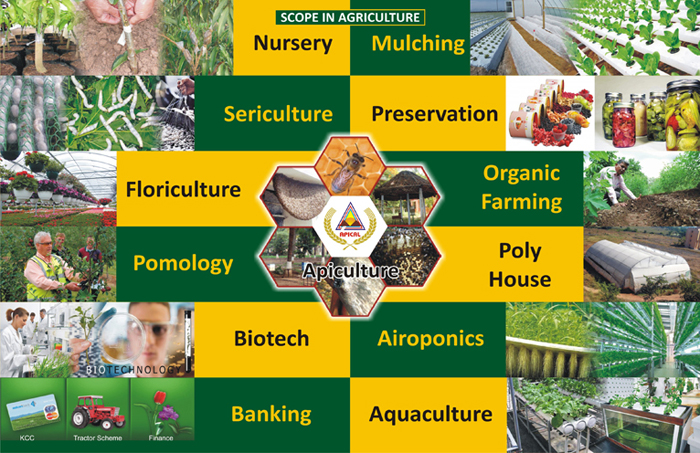
Basic agriculture/agricultural education deals with the study of agricultural science as a subject i.e the teaching of agriculture in schools. A specialist in this area is called agricultural science teacher/lecturer.
Animal science deals with the study of the various farm animals. A specialist in this area is called animal scientist.
Soil science deals with the study of the types of soils. A specialist in this area is called a soil scientist .
Crop science deals with the study of the various type of crops that are cultivated farmers. A specialist in this area is called a crop scientist. Crop science is divided into three: Agronomy(the study of crops and soil ), Pathology(the study of plant and animal diseases), Entomology(the study of insects and pests).
Horticulture deals with of flowers and fruits. Horticulture is divided into three: Pomology (the study of fruits), Floriculture(the study of vegetables),
Floriculture(the study of flowers). A specialist in this area is called a Horticulturist.
Fishery deals with rearing of fish and other aquatic organisms e.g. fish, crabs, crayfish, shrimps, etc. A specialist in this area is called a fishery officer.
Forestry deals with forest trees and forest management . A specialist in this area is called a forest officer or forest guard.
Agricultural economics deals with how to run agriculture as a profitable business. A specialist in this area is called agricultural economist.
Agricultural extension deals with the carrying of information from the research stations to the farmers in the rural areas. A specialist in this area is called extension officer or extension agent.
Agricultural engineering deals with the study of agricultural tools and machines used in agriculture. A specialist in this area known as agricultural engineer.
Veterinary medicine deals with the disease of farm animals. A specialist in this area is called a veterinarian (Veterinary doctor).
EVALUATION:
• Why is agriculture regarded as a science subject?
• List eight branches of agriculture.
LESSON 7
FORMS OF AGRICULTURE
A. Crop farming: It involves the production of different types of crops. They are mostly used as food for man, feed for animals and raw materials for industries Examples of such crops(annual) include maize, rice, mille, sorghum, yam, potatoes, pepper, Soya-bean, groundnut, tomatoes, okra, etc.
Other farmers practice the growing of perennial or permanent crops such as cocoa, oil palm, coffee, rubber, citrus, cashew, kola, guava, mango etc which are also known as cash crops. The system of cropping on a piece of land varies from one place to another and from one farmer to the other. Those who engage in commercial farming for profit making often adopt mono-cropping system (i.e. growing of only one type of crop on the same piece of land at the same time), while most local farmers prefer the growing of different crops on the same piece of land (mixed cropping).
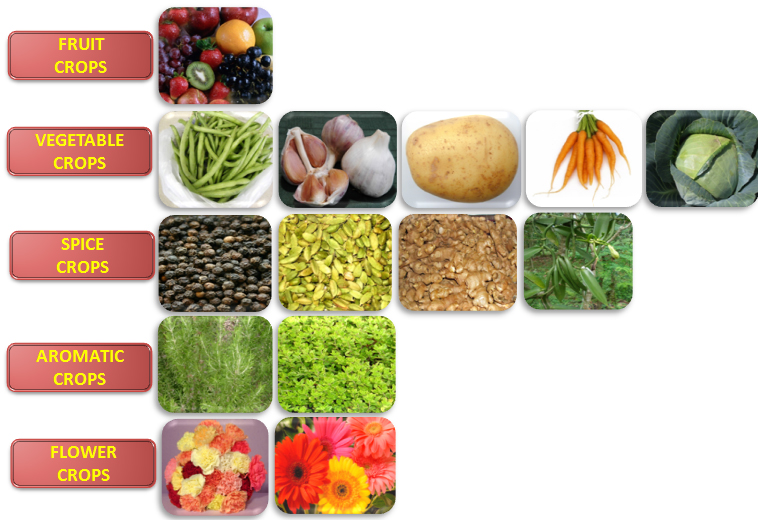
B. Horticulture (Ornamental Plants)
Horticulture is a form of agriculture, which deals with the growing of different kinds of vegetables, fruits and ornamental plants. The vegetable crops include , okra, tomato, pumpkin, cabbage, cucumber, egg plant, water leaves, spinach, bitter leaves, amaranthus etc. Examples of fruits include cashew, citrus, mango, avocado pear, banana, pawpaw, apple, guava etc, while ornamental crops are commonly grown for the beautification of the environment .They include pride of Barbados, hibiscus, croton, zinnia, ixora, queen of the night, and rose flowers, etc
vegetables and fruits are source of minerals and vitamins to human bodies, ornamental plants are very useful for landscaping , attractive parks, gardens, buildings, place of worship, hotels, streets, etc.

C. FISHERY
Fishery (fish farming) refers to production of fish and other aquatic organisms, either for domestic use or profit oriented venture.
Types of Fish good for fish farming
• Heterobranchus
• Tilapia
• Gynacus
• Clarias
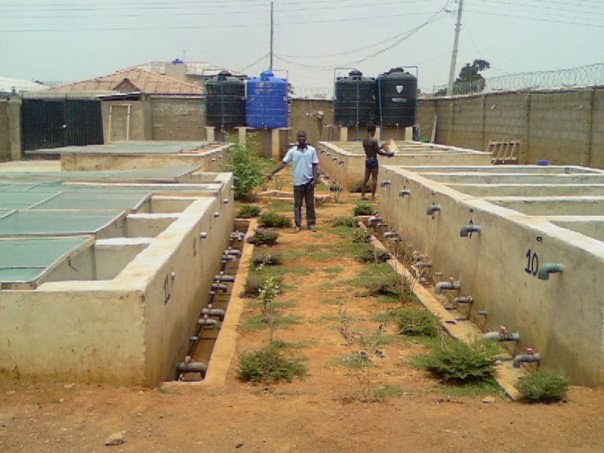

Importance of Fish
• Good Source of Protein
• Contains lesser cholesterol than meat
• Demand for fish is very high – for both rich and poor
• It is recommended for dieting and some vegetarians who do not eat meat
Requirements for Fish farming.
• Pond (Earthen concrete, plastic or galvanized tank can be used as pond
• Source of water could be natural stream, lake, borehole water
• Fingerlings (livestock)
• Feeds e.g. plankton
• Fertilizers
Evaluation:
• What is crop farming?
• State the difference between annual and perennial crops.
• What cropping system do the local farmers that are growing different crops on the same piece of land apply?
• List 10 vegetable crops common in your locality.
• List 5 ornamental plants commonly used for beautifying the environment like school, church.
• With two example each, state the difference between fruit vegetable and leaf vegetable.
Assignment:
Junior secondary Agriculture (workbook 1) by Anthony Youdeowei et-al pages
Visit a fish pond and find out the names of fish there in.
REFERENCE TEXTS:
• Intensive Agricultural Science for J.S.S. 1, 2 & 3 by E. U. Okaro.
• Essentials of Agricultural Science for J.S.S. & Colleges by Earnest Chukwudi Anie.
• Agricultural Science for JSS (Upper Basic Education) by L. A. Are et al.
• Prescribed Agricultural Science for J.S.S. by S. E. Omoruyi et al.
TOPIC: BRANCHES/FORMS OF AGRICULTURE
CONTENT:
i. Scope of Agriculture
ii. Forms of Agriculture.
Scope of Agriculture.
Agriculture involves more than just planting of crops and rearing of animals. It is broad in scope. It is made up of many branches of science. The study of agriculture involves the biology of plants and animals, the Chemistry and Physics of soils, mathematics and other areas. Hence, the study of agriculture as a subject is regarded as agricultural science.
The scope and branches of agriculture includes Basic agriculture, Animal science, soil, crop science, Horticulture, fishery, forestry, Agricultural Economics, Agricultural Extension, Veterinary machine and Agricultural Engineering.

Basic agriculture/agricultural education deals with the study of agricultural science as a subject i.e the teaching of agriculture in schools. A specialist in this area is called agricultural science teacher/lecturer.
Animal science deals with the study of the various farm animals. A specialist in this area is called animal scientist.
Soil science deals with the study of the types of soils. A specialist in this area is called a soil scientist .
Crop science deals with the study of the various type of crops that are cultivated farmers. A specialist in this area is called a crop scientist. Crop science is divided into three: Agronomy(the study of crops and soil ), Pathology(the study of plant and animal diseases), Entomology(the study of insects and pests).
Horticulture deals with of flowers and fruits. Horticulture is divided into three: Pomology (the study of fruits), Floriculture(the study of vegetables),
Floriculture(the study of flowers). A specialist in this area is called a Horticulturist.
Fishery deals with rearing of fish and other aquatic organisms e.g. fish, crabs, crayfish, shrimps, etc. A specialist in this area is called a fishery officer.
Forestry deals with forest trees and forest management . A specialist in this area is called a forest officer or forest guard.
Agricultural economics deals with how to run agriculture as a profitable business. A specialist in this area is called agricultural economist.
Agricultural extension deals with the carrying of information from the research stations to the farmers in the rural areas. A specialist in this area is called extension officer or extension agent.
Agricultural engineering deals with the study of agricultural tools and machines used in agriculture. A specialist in this area known as agricultural engineer.
Veterinary medicine deals with the disease of farm animals. A specialist in this area is called a veterinarian (Veterinary doctor).
EVALUATION:
• Why is agriculture regarded as a science subject?
• List eight branches of agriculture.
LESSON 7
FORMS OF AGRICULTURE
A. Crop farming: It involves the production of different types of crops. They are mostly used as food for man, feed for animals and raw materials for industries Examples of such crops(annual) include maize, rice, mille, sorghum, yam, potatoes, pepper, Soya-bean, groundnut, tomatoes, okra, etc.
Other farmers practice the growing of perennial or permanent crops such as cocoa, oil palm, coffee, rubber, citrus, cashew, kola, guava, mango etc which are also known as cash crops. The system of cropping on a piece of land varies from one place to another and from one farmer to the other. Those who engage in commercial farming for profit making often adopt mono-cropping system (i.e. growing of only one type of crop on the same piece of land at the same time), while most local farmers prefer the growing of different crops on the same piece of land (mixed cropping).

B. Horticulture (Ornamental Plants)
Horticulture is a form of agriculture, which deals with the growing of different kinds of vegetables, fruits and ornamental plants. The vegetable crops include , okra, tomato, pumpkin, cabbage, cucumber, egg plant, water leaves, spinach, bitter leaves, amaranthus etc. Examples of fruits include cashew, citrus, mango, avocado pear, banana, pawpaw, apple, guava etc, while ornamental crops are commonly grown for the beautification of the environment .They include pride of Barbados, hibiscus, croton, zinnia, ixora, queen of the night, and rose flowers, etc
vegetables and fruits are source of minerals and vitamins to human bodies, ornamental plants are very useful for landscaping , attractive parks, gardens, buildings, place of worship, hotels, streets, etc.

C. FISHERY
Fishery (fish farming) refers to production of fish and other aquatic organisms, either for domestic use or profit oriented venture.
Types of Fish good for fish farming
• Heterobranchus
• Tilapia
• Gynacus
• Clarias


Importance of Fish
• Good Source of Protein
• Contains lesser cholesterol than meat
• Demand for fish is very high – for both rich and poor
• It is recommended for dieting and some vegetarians who do not eat meat
Requirements for Fish farming.
• Pond (Earthen concrete, plastic or galvanized tank can be used as pond
• Source of water could be natural stream, lake, borehole water
• Fingerlings (livestock)
• Feeds e.g. plankton
• Fertilizers
Evaluation:
• What is crop farming?
• State the difference between annual and perennial crops.
• What cropping system do the local farmers that are growing different crops on the same piece of land apply?
• List 10 vegetable crops common in your locality.
• List 5 ornamental plants commonly used for beautifying the environment like school, church.
• With two example each, state the difference between fruit vegetable and leaf vegetable.
Assignment:
Junior secondary Agriculture (workbook 1) by Anthony Youdeowei et-al pages
Visit a fish pond and find out the names of fish there in.
REFERENCE TEXTS:
• Intensive Agricultural Science for J.S.S. 1, 2 & 3 by E. U. Okaro.
• Essentials of Agricultural Science for J.S.S. & Colleges by Earnest Chukwudi Anie.
• Agricultural Science for JSS (Upper Basic Education) by L. A. Are et al.
• Prescribed Agricultural Science for J.S.S. by S. E. Omoruyi et al.
WEEK 5
LESSON 8
TOPIC: FORMS OF AGRICULTURE (Cont’d)
LIVESTOCK FARMING
Livestock farming is a form of agriculture that has to do with rearing or keeping of domesticated animals for the production of milk, meat, hides and skins, egg and other purpose. Farm animals commonly reared by livestock farmers include cattle, goats, pigs (in the south only), sheep, rabbit, and poultry birds (e.g. fowls, turkey, duck, etc).
There are two major ways of practicing livestock farming in Nigeria. The traditional or extensive method whereby the animals are left to fend for themselves with little or no attention. There is no housing, no care and they are exposed to dangers. In the northern part of Nigeria, the herdsmen or Fulani cattle rearers move their animals from place to place in search of green pastures and water.
Under the intensive or modern method, the animals enjoy proper management and care with organized housing, balanced feeding, hygiene and control of diseases and pests.
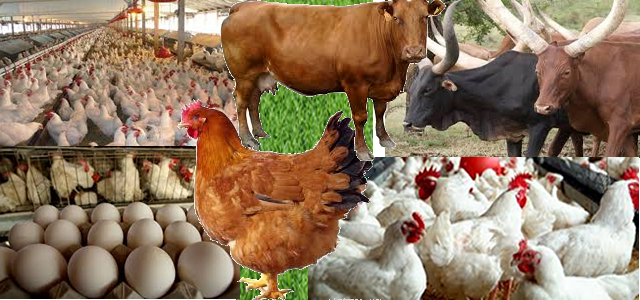
APICULTURE (Bee Farming)
This is a form of agriculture that has to do with deliberate keeping of bees as a business. It is quite different from the natural type in the sense that the farmer creates artificial location with enough raw materials in a potential bee path.
Materials:
• Beehives/Box-hives and wax foundation sheets for each beehive.
• Garments/wears for preventing bee stings: Bee suits, boots/shoes, hive tool and smoker.
• Knives, hand gloves, brush and packaging bottles for processing.
Construction of Housing for Bee Production:
Construct two-chamber wooden boxes with a removable zinc or aluminum top liner coating and place in a location that will attract bees. It is important to clear the environment to avoid bush fire. Place about twenty (20) wax foundation sheets in each beehive. Put a little honey or palm wine in a container and place in the box or beehive to attract the bees. As many as 30 or more boxes can be set up in a small area.
As the bees feed on sweet foods of plants, they make honey and deposit honey in the honeycomb until it becomes ripe. Then the bees seal the comb, which becomes airtight and brownish in colour. Harvesting is done as from 4-6 months. A box hive yields about 12 litres of honey every 4 weeks. Honey is very high in demand for health considerations. It can also be used for producing creams , candles.and medicine , There is the need for the beginner to undergo training by studying the behaviour of bees to avoid possible attack.
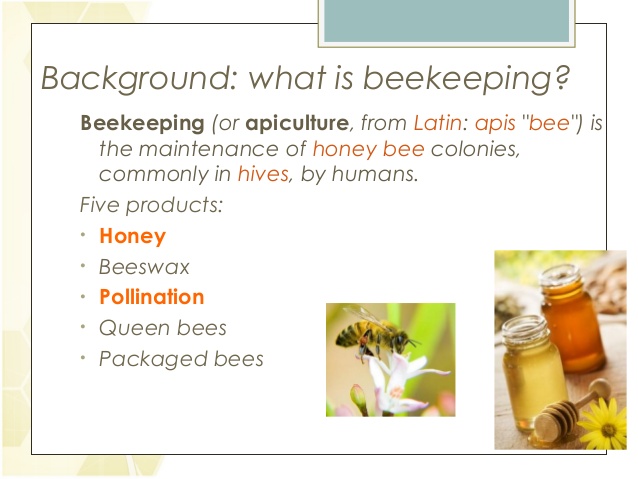
Evaluation:
• Define livestock farming.
• List five types of domesticated animals commonly reared by livestock farmers.
• Explain the two major ways of practicing livestock farming in Nigeria.
• List the materials needed for establishing bee farming.
• Explain how bee-farming housing can be constructed.
• Give some uses of honey.
LESSON 9
SNAIL REARING (SNAILRY)
Heliculture is the practice of rearing or raising snails
FEATURES OF SNAIL
• It is in a class called mollusc
• It is tough and blue-blooded
• It is covered with shell
• It has no threat to human health when eaten as meat. It is instead recommended for diabetic patients, High Blood Pressure (HBP) patients, and health conscious individuals. The liquid in its body is recommended for the treatment of asthma, blood deficiency, etc. It is a seasonal meat (found only in rainy season). There is therefore, high demand for snail as meat hence, the need to keep it domestically.
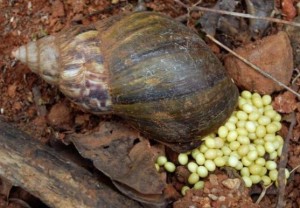
Housing Requirements:
The houses are of various forms to suit your need in terms of space and capital available.
• Piled motor tyres with net lid
• Pots or drums constructed
• Hutches or cages/boxed fenced pens
• Plantain plantation fenced with net wire.
Management/Skills Required
Choose the breed that can lay more eggs – male and female.
It is cheaper than any other livestock to run comparing the input with the expected return. The labour is simple and feeding is not costly. The source of breed is very simple – you purchase the breed that will benefit your project in terms of high yield. Snails feed on green leaves of cocoyam, cassava, pawpaw, spinach, waterleaf, centrosemna and unripe fruits such as pawpaw, banana, plantain, tomato, etc; tubers and flowers. Salt should not be added to any snail feed to prevent them from dying.
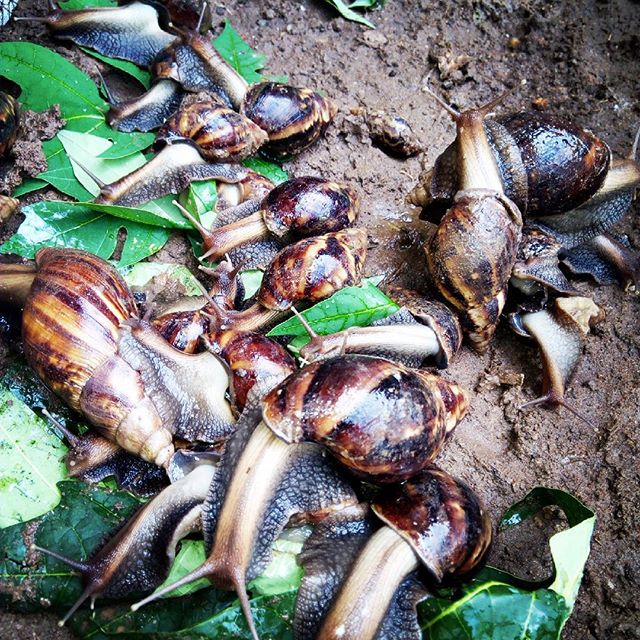
Evaluation:
• List 4 various house forms of snail.
• State 4 reasons why the demand of snail meat is high in the society.
• State five different feeds of snails.
Activity: Familiarize yourself with the various forms of agriculture through the study of charts and pictures
REFERENCE TEXTS:
• Intensive Agricultural Science for J.S.S. 1, 2 & 3 by E. U. Okoro.
• Essentials of Agricultural Science for J.S.S. & Colleges by Earnest Chukwudi Anie.
• Agricultural Science for JSS (Upper Basic Education) by L. A. Are et al.
• Prescribed Agricultural Science for J.S.S. by S. E. Omoruyi et al.
TOPIC: FORMS OF AGRICULTURE (Cont’d)
LIVESTOCK FARMING
Livestock farming is a form of agriculture that has to do with rearing or keeping of domesticated animals for the production of milk, meat, hides and skins, egg and other purpose. Farm animals commonly reared by livestock farmers include cattle, goats, pigs (in the south only), sheep, rabbit, and poultry birds (e.g. fowls, turkey, duck, etc).
There are two major ways of practicing livestock farming in Nigeria. The traditional or extensive method whereby the animals are left to fend for themselves with little or no attention. There is no housing, no care and they are exposed to dangers. In the northern part of Nigeria, the herdsmen or Fulani cattle rearers move their animals from place to place in search of green pastures and water.
Under the intensive or modern method, the animals enjoy proper management and care with organized housing, balanced feeding, hygiene and control of diseases and pests.

APICULTURE (Bee Farming)
This is a form of agriculture that has to do with deliberate keeping of bees as a business. It is quite different from the natural type in the sense that the farmer creates artificial location with enough raw materials in a potential bee path.
Materials:
• Beehives/Box-hives and wax foundation sheets for each beehive.
• Garments/wears for preventing bee stings: Bee suits, boots/shoes, hive tool and smoker.
• Knives, hand gloves, brush and packaging bottles for processing.
Construction of Housing for Bee Production:
Construct two-chamber wooden boxes with a removable zinc or aluminum top liner coating and place in a location that will attract bees. It is important to clear the environment to avoid bush fire. Place about twenty (20) wax foundation sheets in each beehive. Put a little honey or palm wine in a container and place in the box or beehive to attract the bees. As many as 30 or more boxes can be set up in a small area.
As the bees feed on sweet foods of plants, they make honey and deposit honey in the honeycomb until it becomes ripe. Then the bees seal the comb, which becomes airtight and brownish in colour. Harvesting is done as from 4-6 months. A box hive yields about 12 litres of honey every 4 weeks. Honey is very high in demand for health considerations. It can also be used for producing creams , candles.and medicine , There is the need for the beginner to undergo training by studying the behaviour of bees to avoid possible attack.

Evaluation:
• Define livestock farming.
• List five types of domesticated animals commonly reared by livestock farmers.
• Explain the two major ways of practicing livestock farming in Nigeria.
• List the materials needed for establishing bee farming.
• Explain how bee-farming housing can be constructed.
• Give some uses of honey.
LESSON 9
SNAIL REARING (SNAILRY)
Heliculture is the practice of rearing or raising snails
FEATURES OF SNAIL
• It is in a class called mollusc
• It is tough and blue-blooded
• It is covered with shell
• It has no threat to human health when eaten as meat. It is instead recommended for diabetic patients, High Blood Pressure (HBP) patients, and health conscious individuals. The liquid in its body is recommended for the treatment of asthma, blood deficiency, etc. It is a seasonal meat (found only in rainy season). There is therefore, high demand for snail as meat hence, the need to keep it domestically.

Housing Requirements:
The houses are of various forms to suit your need in terms of space and capital available.
• Piled motor tyres with net lid
• Pots or drums constructed
• Hutches or cages/boxed fenced pens
• Plantain plantation fenced with net wire.
Management/Skills Required
Choose the breed that can lay more eggs – male and female.
It is cheaper than any other livestock to run comparing the input with the expected return. The labour is simple and feeding is not costly. The source of breed is very simple – you purchase the breed that will benefit your project in terms of high yield. Snails feed on green leaves of cocoyam, cassava, pawpaw, spinach, waterleaf, centrosemna and unripe fruits such as pawpaw, banana, plantain, tomato, etc; tubers and flowers. Salt should not be added to any snail feed to prevent them from dying.

Evaluation:
• List 4 various house forms of snail.
• State 4 reasons why the demand of snail meat is high in the society.
• State five different feeds of snails.
Activity: Familiarize yourself with the various forms of agriculture through the study of charts and pictures
REFERENCE TEXTS:
• Intensive Agricultural Science for J.S.S. 1, 2 & 3 by E. U. Okoro.
• Essentials of Agricultural Science for J.S.S. & Colleges by Earnest Chukwudi Anie.
• Agricultural Science for JSS (Upper Basic Education) by L. A. Are et al.
• Prescribed Agricultural Science for J.S.S. by S. E. Omoruyi et al.
WEEK 6
LESSON 10
TOPIC: CROP PLANT FORM.
CONTENT: i. Plant parts
ii. Functions of each plant parts.
Different parts of plants
Plant form refers to the shape of a plant. Flowering plants have two regions: the shoot region, which is found above the ground level and the root region which is found below the ground level.
PARTS OF A FLOWERING PLANTS
A flowering crop plant has the following parts
• The leaves
• The flowers
• The branches
• The stem
• The roots
Flowers, leaves, branches and stem comprise the shoot region or system while the different roots comprise the root regions system.
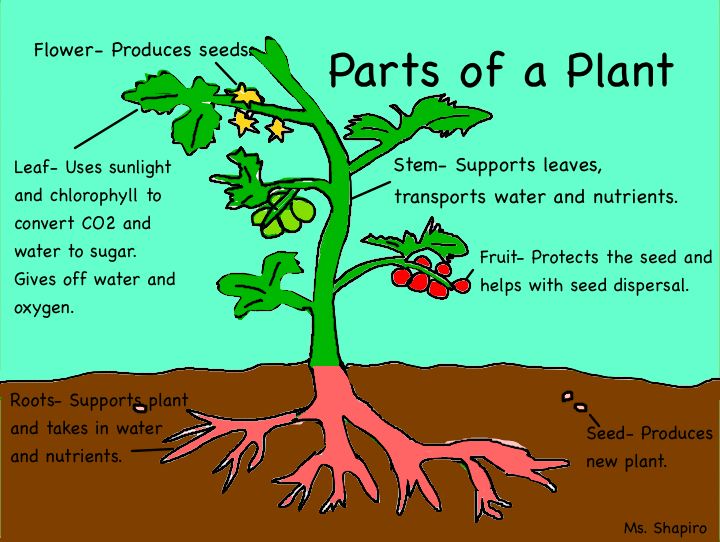
Functions of the parts of a plant
The leaves: The leaves of a plant perform the following functions.
• Manufacture food through the process of photosynthesis
• Some leaves store food e.g. onions, cabbage, waterleaf.
• Some leaves are used for propagation e.g. Bryophyllium
• The leaves permit air to enter leaves the plant through the stomata.
• The leaves give the shape of the plant.
The flowers: The functions of the flowers include the following.
• Bright scented flowers attracts insects for pollination
• The flowers produce the fruits and seeds
• Some plant flowers are eaten by man
• Use for decoration/they adds beauty to the plants.
• They release sweet odour.
The branches: The function of the branches includes the following
• They help to hold the leaves and fruits in shape
• Some plant branches are used for propagation.
The stem: The functions of the include:
• They help to transfer food nutrients from the roots up to the leaves and flowers.
• Also, it brings down the manufactured food form the leaves to other parts of the body
• They are used for propagation e.g. cassava stem
• It carries the branches, leaves and flower
• Some plant stems store food e.g. yam, Irish potato and sugar cane.
The root: The functions of the roots include
• It holds the plant firmly to the ground
• It absorbs minerals and water from the soil.
• Some plant roots store food e.g. cassava and carrot
• Some plant roots are medicinal.
EVALUATION
1. Differentiate between shoot system and root system and name their parts.
2. Outline two functions each of
• The leaves
• The flowers
• The branches
3. State any 3 functions each of the stem and the root.
Assignment:
Students to get any of the part of the plant, identify and draw it, and write its functions
Junior secondary Agriculture (workbook 1)byAnthony.Youdeowei et-al page 5-7,16.
REFERENCE TEXTS:
• Intensive Agricultural Science for J.S.S. 1, 2 & 3 by E. U. Okaro.
• Essentials of Agricultural Science for J.S.S. & Colleges by Earnest Chukwudi Anie.
• Agricultural Science for JSS (Upper Basic Education) by L. A. Are et al.
• Prescribed Agricultural Science for J.S.S. by S. E. Omoruyi et al.
TOPIC: CROP PLANT FORM.
CONTENT: i. Plant parts
ii. Functions of each plant parts.
Different parts of plants
Plant form refers to the shape of a plant. Flowering plants have two regions: the shoot region, which is found above the ground level and the root region which is found below the ground level.
PARTS OF A FLOWERING PLANTS
A flowering crop plant has the following parts
• The leaves
• The flowers
• The branches
• The stem
• The roots
Flowers, leaves, branches and stem comprise the shoot region or system while the different roots comprise the root regions system.

Functions of the parts of a plant
The leaves: The leaves of a plant perform the following functions.
• Manufacture food through the process of photosynthesis
• Some leaves store food e.g. onions, cabbage, waterleaf.
• Some leaves are used for propagation e.g. Bryophyllium
• The leaves permit air to enter leaves the plant through the stomata.
• The leaves give the shape of the plant.
The flowers: The functions of the flowers include the following.
• Bright scented flowers attracts insects for pollination
• The flowers produce the fruits and seeds
• Some plant flowers are eaten by man
• Use for decoration/they adds beauty to the plants.
• They release sweet odour.
The branches: The function of the branches includes the following
• They help to hold the leaves and fruits in shape
• Some plant branches are used for propagation.
The stem: The functions of the include:
• They help to transfer food nutrients from the roots up to the leaves and flowers.
• Also, it brings down the manufactured food form the leaves to other parts of the body
• They are used for propagation e.g. cassava stem
• It carries the branches, leaves and flower
• Some plant stems store food e.g. yam, Irish potato and sugar cane.
The root: The functions of the roots include
• It holds the plant firmly to the ground
• It absorbs minerals and water from the soil.
• Some plant roots store food e.g. cassava and carrot
• Some plant roots are medicinal.
EVALUATION
1. Differentiate between shoot system and root system and name their parts.
2. Outline two functions each of
• The leaves
• The flowers
• The branches
3. State any 3 functions each of the stem and the root.
Assignment:
Students to get any of the part of the plant, identify and draw it, and write its functions
Junior secondary Agriculture (workbook 1)byAnthony.Youdeowei et-al page 5-7,16.
REFERENCE TEXTS:
• Intensive Agricultural Science for J.S.S. 1, 2 & 3 by E. U. Okaro.
• Essentials of Agricultural Science for J.S.S. & Colleges by Earnest Chukwudi Anie.
• Agricultural Science for JSS (Upper Basic Education) by L. A. Are et al.
• Prescribed Agricultural Science for J.S.S. by S. E. Omoruyi et al.
WEEK 7
LESSON 11
TOPIC: Crop Plant Forms.(cont`d)
CONTENT: i. Aquatic plants
ii. Broad leafed crops
iii. Narrow leafed crops
Aquatic Plants
Crops plant can as well be grouped into the following:
These are plants that can grow and survive in water bodies (rivers, lake, pond, stream) examples of such plant crops include water lettuce, green algae, water hyacent plankton. Aquatic animals like fish; crabs, lobsters, crayfish, crocodile, water tortoise etc mostly eat most of these aquatic plants.
Terrestrial plants – these are plants that grow and survive on the land. Examples include: beans, yam, rice, oil palm, coconuts, etc. They are mostly eaten by terrestrial animals including man.

Broad and Narrow leaf
Broad leafed crops
These are crop plant that their leaves grow wide or broad in shape. They can be cut and spread on the ground for drying grains and seeds like maize and melon. They can also be used to cover compost manure during and after its preparation. Plant with broad leaves include, plantain, banana, coco yam, Okra etc.

Narrow leaf
These are crop plants that their leaves grow narrow in shape. They are usually found in monocotyledons crop plants. The leaves are usually eaten by ruminants animals like cow, goat, and sheep. Examples of narrow leaves crops include maize, rice, guinea corn, millet and guinea grass, elephant grass.
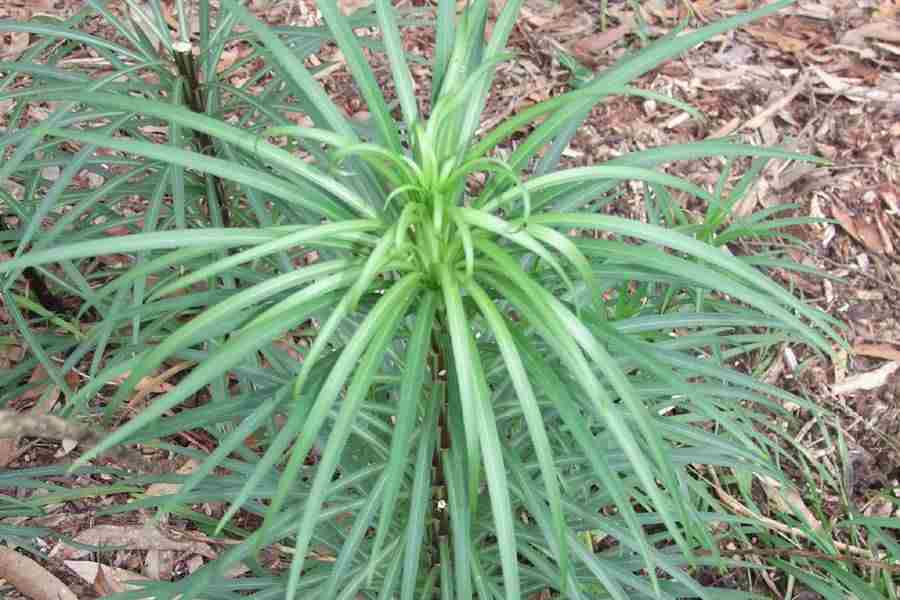
Elephant grass
Grass leaves
Plantain plant leaves
Coconut plant
Water hyacent
EVALUATION
(i) List 4 examples of aquatic plants
(ii) What are terrestrial plants? Name two common ones in your locality.
(iii) Explain broad and narrow leafed plants.
(iv) Give 4 examples of broad leafed crop
(v) List 4 examples of narrow leafed plants.
Assignment:
Junior secondary Agriculture (workbook 1) by Anthony.Youdeowei et-al pages
REFERENCE TEXTS:
• Intensive Agricultural Science for J.S.S. 1, 2 & 3 by E. U. Okoro.
• Essentials of Agricultural Science for J.S.S. & Colleges by Earnest Chukwudi Anie.
• Agricultural Science for JSS (Upper Basic Education) by L. A. Are et al.
• Prescribed Agricultural Science for J.S.S. by S. E. Omoruyi et al.
TOPIC: Crop Plant Forms.(cont`d)
CONTENT: i. Aquatic plants
ii. Broad leafed crops
iii. Narrow leafed crops
Aquatic Plants
Crops plant can as well be grouped into the following:
These are plants that can grow and survive in water bodies (rivers, lake, pond, stream) examples of such plant crops include water lettuce, green algae, water hyacent plankton. Aquatic animals like fish; crabs, lobsters, crayfish, crocodile, water tortoise etc mostly eat most of these aquatic plants.
Terrestrial plants – these are plants that grow and survive on the land. Examples include: beans, yam, rice, oil palm, coconuts, etc. They are mostly eaten by terrestrial animals including man.

Broad and Narrow leaf
Broad leafed crops
These are crop plant that their leaves grow wide or broad in shape. They can be cut and spread on the ground for drying grains and seeds like maize and melon. They can also be used to cover compost manure during and after its preparation. Plant with broad leaves include, plantain, banana, coco yam, Okra etc.

Narrow leaf
These are crop plants that their leaves grow narrow in shape. They are usually found in monocotyledons crop plants. The leaves are usually eaten by ruminants animals like cow, goat, and sheep. Examples of narrow leaves crops include maize, rice, guinea corn, millet and guinea grass, elephant grass.

Elephant grass
Grass leaves
Plantain plant leaves
Coconut plant
Water hyacent
EVALUATION
(i) List 4 examples of aquatic plants
(ii) What are terrestrial plants? Name two common ones in your locality.
(iii) Explain broad and narrow leafed plants.
(iv) Give 4 examples of broad leafed crop
(v) List 4 examples of narrow leafed plants.
Assignment:
Junior secondary Agriculture (workbook 1) by Anthony.Youdeowei et-al pages
REFERENCE TEXTS:
• Intensive Agricultural Science for J.S.S. 1, 2 & 3 by E. U. Okoro.
• Essentials of Agricultural Science for J.S.S. & Colleges by Earnest Chukwudi Anie.
• Agricultural Science for JSS (Upper Basic Education) by L. A. Are et al.
• Prescribed Agricultural Science for J.S.S. by S. E. Omoruyi et al.
WEEK 8
LESSON 12
TOPIC: CROP PLANT FORMS(CONT`D)
CONTENT:
i. Monocotyledon and Dicotyledon plants
ii. Difference between monocotyledon and Dicotyledon plants
Monocotyledon and Dicotyledonous.
Monocotyledons plants: These are plants with one seed leaf or Cotyledons e.g. maize, rice, oil palm, coconut, wheat, millet, banana etc.
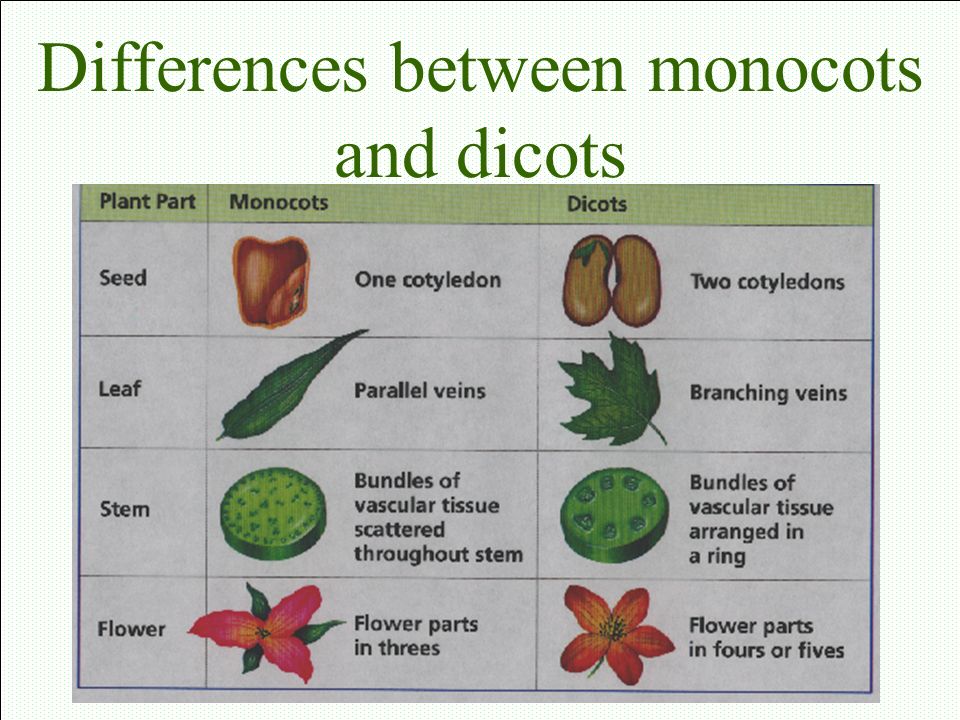

Dicotyledonous plants: These are plants with two seed leaves or cotyledons e.g. cowpea, mango, citrus, cashew groundnuts, tomatoes, kola, mango etc.
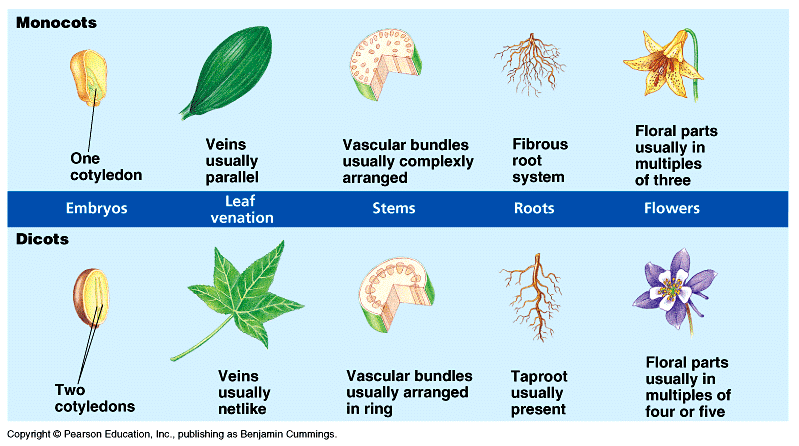
DIFFERENCE BETWEEN MONOCOTYLEDONS & DICOTYLEDONS
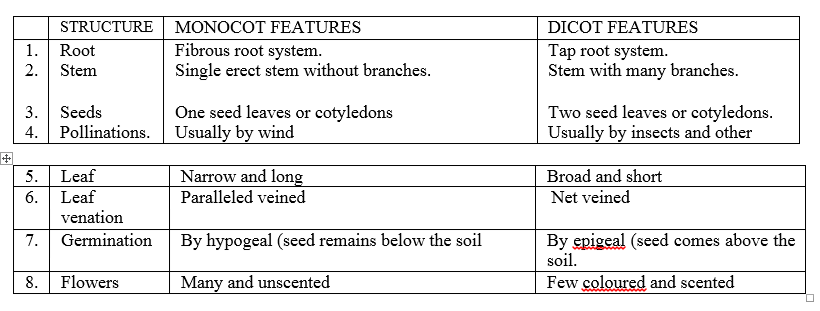
EVALUATION
(i) List five crops that are monocotyledons and five crops that are dicotyledous.
(ii) State 6 differences between monocotyledons and dicotyledous.
Diagrams: draw
A monocot plant of maize with its complete parts
A dicot plant e.g. tomatoes with its complete parts.
ASSIGNMENT
Draw a germinating seedling of maize and cowpea to show hypogeal and epigeal germination.
PRACTICAL ASSIGNMENT
Plant maize and groundnut seeds and observe them after germination and classify them into monocotyledons and dicotyledons.
TOPIC: CROP PLANT FORMS(CONT`D)
CONTENT:
i. Monocotyledon and Dicotyledon plants
ii. Difference between monocotyledon and Dicotyledon plants
Monocotyledon and Dicotyledonous.
Monocotyledons plants: These are plants with one seed leaf or Cotyledons e.g. maize, rice, oil palm, coconut, wheat, millet, banana etc.


Dicotyledonous plants: These are plants with two seed leaves or cotyledons e.g. cowpea, mango, citrus, cashew groundnuts, tomatoes, kola, mango etc.

DIFFERENCE BETWEEN MONOCOTYLEDONS & DICOTYLEDONS

EVALUATION
(i) List five crops that are monocotyledons and five crops that are dicotyledous.
(ii) State 6 differences between monocotyledons and dicotyledous.
Diagrams: draw
A monocot plant of maize with its complete parts
A dicot plant e.g. tomatoes with its complete parts.
ASSIGNMENT
Draw a germinating seedling of maize and cowpea to show hypogeal and epigeal germination.
PRACTICAL ASSIGNMENT
Plant maize and groundnut seeds and observe them after germination and classify them into monocotyledons and dicotyledons.